Los Fundamentos del Universo a Través de Filosofía y la Política : Primera Parte (The Basics of the Universe through Philosophy and Politics : Part 1)
- By Elvia Ramirez-Vidal
- July 31, 2013
- Comments Off on Los Fundamentos del Universo a Través de Filosofía y la Política : Primera Parte (The Basics of the Universe through Philosophy and Politics : Part 1)
[Sara’s note: We are once again thrilled to have a bilingual blog from Elvia – this is the first part in a short series about the historical intersection of astronomy, philosophy, and politics. A translation to English follows the Spanish text.]
Si hay un área en el estudio del universo que realmente me ha cautivada, son los elementos históricos que nos han llevado hasta donde estamos ahora mismo. A través de varios siglos de la humanidad, ha habido implicaciones filosóficas y políticas que han moldeado nuestro conocimiento en lo que sabemos sobre y más allá de nuestra pequeña canica azul. Al aprender acerca de la historia de la ciencia, muchos se sorprenden al descubrir que el primer “título” para los científicos era en realidad filósofos naturales. A solo pensar, estos chicos filosofaban acerca de la naturaleza en la forma en que funciona y las leyes que se atribuye basado en nada más que observaciones y sus pensamientos. Uno de los más famosos filósofos naturales fue Platón cuya escritura incluye el diálogo de Timeo, que estaba destinado a explicar el universo en el contexto de la naturaleza, las propiedades y la creación. Aunque en la formación del universo de Platón había ciertas cosas que sólo podía explicar usando términos metafísicos como el Prime Mover y el Creador, había temas centrales como el de cómo se produjo orden del desorden que fue examinado en diferentes disciplinas. Este fue uno de los primeros ejemplos en los que se utilizó una aplicación de propiedades matemáticas conocidas como los sólidos platónicos para describir la formación de nuestro universo, junto con el uso de los elementos metafísicos en cual escribió mucho de.

Se creía que había cinco sólidos platónicos en acuerdo con los cinco elementos del universo: fuego (tetraedro), tierra (cubo), aire (octaedro), agua (icosaedro), y el cosmo (dodecaedro).
Crédito: Cyp
Las ideas de Platón influyeron a su estudiante Aristóteles a mirar al Universo en mayor profundidad. A través del método científico en que él concibió, Aristóteles creó un universo esférico incluyendo: la Tierra en el centro, la luna, las estrellas errantes (planetas), una esfera de estrellas fijas y, finalmente, una esfera para el Prime Mover. En esta manera aristotélica y teleológica de explicar el Universo, una marca fue dejada hasta el tiempo de Copérnico. Para mi, siempre es fascinante leer como estos filósofos naturales tenían estas opiniones teológicas tan profundas cuando miraban hacia el cielo, mientras que la batalla entre la religión y la ciencia se ha convertido en un acertijo moderno en donde los dos lados (generalmente) son muy divididos. Aunque ahora sabemos que Aristóteles estaba equivocado al pensar que la Tierra era único, perfecto, y al centro del Universo, la idea de un Prime Mover trasciende a través de los siglos y nos es hasta Galileo que aprendemos que estos paradigmas son incorrectos. ¡Eso es alrededor de 800 años en cual ese paradigma incorrecto fue reinante!

Lamentablemente, no puedo traducir al latín muy bien, pero esta imagen es la que puede poner la “vieja manera” de pensar en perspectiva.
Es muy importante recordar que todo esto fue hecho por los filósofos quienes solo hicieron observaciones. El telescopio no fue inventado hasta los principios de 1600 y no fue hasta el año 276 AC en cual vino Eratóstenes (cientifico/matematico griego) y aplicó matemáticas con un papel pesado al Universo. Esto fue a través del método que Eratóstenes usó para medir el tamaño de la Tierra durante el solsticio de verano aproximadamente en el año 240 AC. El uso “stadias” como su unidades de distancia, así que nunca sabremos si estaba a lo más cercano de 1% o el 16% de la circunferencia correcta. ¡Esto es impresionante teniendo en cuenta que el uso el álgebra y la geometría bastante básico para medir la tierra con poco herramientas! Alrededor del tiempo en cual estábamos descubriendo la circunferencia de la Tierra, Aristarco estaba ocupado cambiando el modelo entero a través de calculaciones entre la relación de la Tierra, la luna, y el sol. Al darse cuenta de que no había paralaje observable, el empezó a creer que las estrellas estuvieran mucho más lejos de lo que pensaba anteriormente y entonces cambió nuestro universo para que fuera heliocéntrica.

Obviamente esto esta un -poco- fuera de proporción pero las simples implicaciones geométricas son lo que importa.
Crédito: NOAA Ocean Service Education
Aunque esta sea un panorama muy breve acerca de los comienzos del universo como lo sabemos hoy en día, es importante de tomar en cuenta lo tanto que la filosofía ha influido nuestros resultados. En nuestro tiempo moderno, generalmente pensamos en la filosofía como el deambular de la mente y la postulación que se produce cuando preguntamos cuestiones como “¿cuál es el significado de la vida”, ¿tenemos libre albedrío “y” ¿hay vida después de la muerte?”. En el comienzo de la civilización humana, este fue el caso, pero la base de la ciencia se estaba formando. La observacion, hipotesis, y los datos que fueron recogidos promovieron los módulos que estos filósofos naturales estaban aplicando para ser verdad de nuestro alrededor. Matemáticas despues entro a los módulos y fortalecieron sus teorías a lo largo de los comienzos del álgebra y la geometría. En el siguiente blog vamos a centrarnos más en como las implicaciones filosóficas se giran en la dirección política alrededor del tiempo de el último cosmólogo aristotélico, Copérnico.

Aunque se vean bastantemente seriosos aqui, los filósofos fueron más allá de diálogos sobre la vida y la muerte. A veces se tomaron el tiempo para simplemente mirar a las estrellas y asombrarse.
If there is one area in the study of the Universe that really has intrigued me, it is the historical elements that have brought us to where we are now. Throughout several centuries of mankind, there have been philosophical and political implications that have molded our knowledge on what we know about and beyond our small blue marble. When learning about the history of science, many are surprised to find that the first “title” for scientists was actually natural philosophers. Just think, these guys philosophized about nature – the ways that it works and the laws attached to it – based off of nothing more than observations and their thoughts. One of our most famous natural philosophers was Plato. His writing includes the dialogue of Timaeus which was meant to explain the Universe in the context of nature, properties, and creation. Although in Plato’s formation of the Universe there were certain things that he could only explain using metaphysical terms such as a Prime Mover and Creator, there was the focus of how order came about from disorder, which was used in different disciplines. This was one of the first examples in which an application of mathematical properties known as the Platonic solids was used to describe the formation of our Universe along with using the metaphysical elements he greatly wrote about.

It was believed that there were five Platonic solids for the five elements which make up the Universe: fire (tetrahedron), earth (cube), air (octahedron), water (icosahedron), and the cosmos (dodecahedron).
Credit: Cyp
Plato’s views were what influenced his student Aristotle to look at the Universe in more depth. Through the scientific method that he conceived, Aristotle created a spherical Universe including: Earth in the center, the Moon, the wandering stars (planets), a sphere for fixed stars, and finally a sphere for the Prime Mover. This Aristotelian and teleological way of explaining the Universe made its mark up until Copernicus’ time. It’s always fascinating to read how these natural philosophers had such deep theological views when looking heavenwards, while the battle between religion and science has become a modern day conundrum in where the sides are (usually) heavily split. Although we now know that Aristotle was wrong in thinking the Earth was unique, perfect, and the center of the Universe, the idea of a Prime Mover transcends through the centuries – it isn’t until Galileo comes along that many of these ideas are considered wrong. That is about an 800 year old reign of this old paradigm!

Unfortunately, I cannot translate into Latin all too well but this image is one that can visually put the “old way” of thinking into perspective.
It is important to remember that all this was done by philosophers making observations with the naked eye and with little to no significant technological advances. I mean, the telescope would not be invented until the early 1600s and it was not until Eratosthenes (a Greek scientist/mathematician) came along in 276 BCE that mathematics began its heavy role in defining the Universe. This was through the method Eratosthenes used to measure the size of the Earth during the summer solstice in about the year 240 B.C. He used “stadia” as his distance units which to this day has no precise measurement attached to the unit itself; all we do know is he was as close as 1% to 16% of the correct circumference. Even if the measurements were about 16% off from the correct circumference, this is outstanding considering he used pretty basic algebra and geometry to measure the Earth with a small number of tools! Around the time we were finding out about the circumference of the Earth, Aristarchus was busy changing the entire model around through calculations of the relationship between the Earth, Sun, and the Moon. From his realization that there was no observable parallax, he believed the stars to be further away than previously thought and also changed our views of the Universe from geocentric to heliocentric.

Obviously this is a -bit- out of proportion but the simple geometric implications are what matters
Credit: NOAA Ocean Service Education
Although this is a very quick overview of the early understandings of “the Universe” as we now know it to be, it is important to note just how much philosophy has influenced our findings. In our modern day, we usually think of philosophy as the wandering of the mind and the postulation that occurs around questions such as “what is the meaning of life”, “do we have free will” and “is there life after death.” In the beginnings of human civilization, this was the case, but the basis of science was also forming. Observation, hypothesizing, and data collecting all furthered the modules that these natural philosophers were implementing to be understand our surroundings. Mathematics then came into the modules and strengthened their theories all through the beginnings of algebra and geometry.
In the next blog we will focus more on how the philosophical implications turn political right around the time of the last Aristotelian cosmologist, Copernicus.

Although pretty serious looking here, natural philosophers went beyond dialogues pertaining to life and death. Sometimes they took the time to just look up at the stars and wonder!


